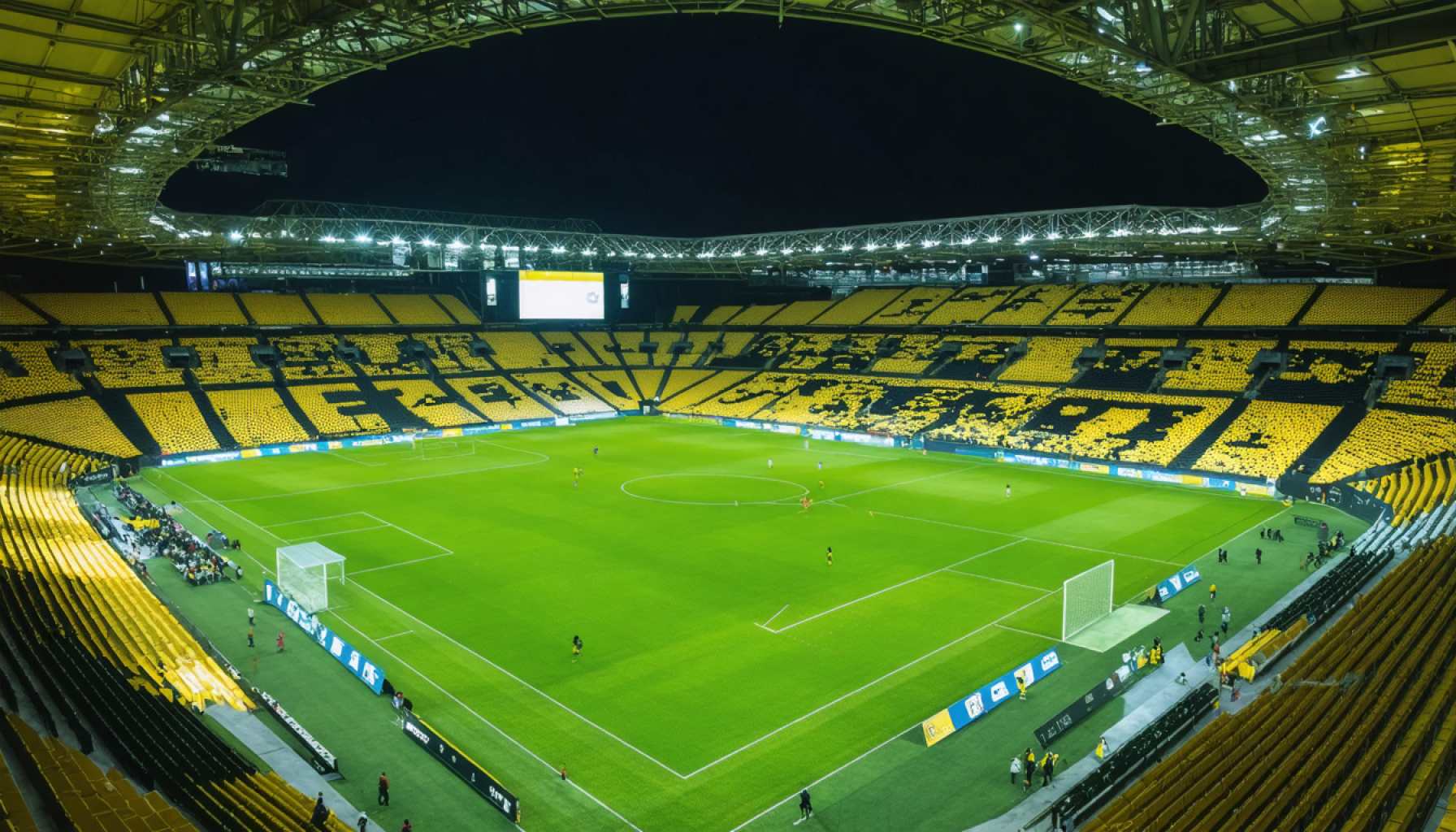- Signal Iduna Park is set to become the world’s largest solar-powered stadium with over 11,000 advanced PV modules installed on its roof.
- The project, in collaboration with Borussia Dortmund and JA Solar, will generate over 4 MWh annually, significantly reducing the club’s carbon emissions by 1,800 tons of CO₂ each year.
- Installation is scheduled for summer 2025, aligning with the sustainable energy goals promoted by UEFA and SolarPower Europe.
- Borussia Dortmund’s initiative reflects a long-term commitment to sustainability, as emphasized by Managing Director Carsten Cramer and JA Solar’s Henning Schulze.
- Signal Iduna Park will symbolize the union of football and sustainable innovation, showcasing the club’s dedication to environmental responsibility.
Signal Iduna Park, the fortress of Borussia Dortmund, is poised to shatter records not with a football, but with a wave of sunlight cascading upon its iconic roof. This arena, famed for hosting over 80,000 spirited fans every game, will soon boast the world’s largest solar power installation on a stadium.
Solar Surge in the Heart of Football
The formidable collaboration between Borussia Dortmund and China’s JA Solar promises more than just another trophy in the cabinet of sustainable initiatives. More than 11,000 cutting-edge PV modules will transform the arena’s roof into a sprawling solar tapestry. This eco-innovation is set to generate over 4 MWh annually, harnessing enough energy to power the stadium’s own operations. Beyond its own use, the system marks a critical juncture in reducing carbon emissions and diminishing the club’s ecological footprint, by an amazing 1,800 tons of CO₂ each year.
A Legacy Beyond the Pitch
As the project takes shape, it captures the essence of a broader movement spearheaded by UEFA and SolarPower Europe, aiming to marry Europe’s beloved sport with sustainable energy. The timing couldn’t be more impeccable, with installation set to begin in the summer of 2025—a visionary merge of sport and sustainability.
This commitment reflects the club’s long-term vision. Borussia Dortmund’s Managing Director, Carsten Cramer, emphasized the importance of looking beyond short-term gains, instead embracing a future where every goal and cheer echoes alongside a commitment to the planet. Henning Schulze of JA Solar reinforced this sentiment, declaring the company’s enduring dedication to global environmental advancement.
In Solar We Trust
This collaboration sends ripples across the globe, transforming a football match into a beacon of environmental consciousness. As Signal Iduna Park bathes in solar brilliance, it stands as a testament to what is possible when passion meets purpose. It’s not merely about harnessing the sun’s energy; it’s about leading the charge towards a brighter, greener future.
Soccer Stadiums Go Green: The Dawn of Sustainable Arenas
Borussia Dortmund’s Solar Power Revolution
The installation of what will become the largest solar power system atop a stadium signifies a monumental shift not just for Borussia Dortmund but for sports venues worldwide. As Signal Iduna Park prepares to embrace solar power beyond its regular football festivities, let’s explore additional facets of this groundbreaking initiative and its implications.
How Solar Technology Transforms Sporting Arenas
1. Environmental Impact: By generating over 4 MWh annually, the solar panels will significantly reduce carbon emissions, echoing the urgent call for sustainable practices. The estimated reduction of 1,800 tons of CO₂ each year is akin to removing nearly 400 cars from the road annually.
2. Economic Benefits: Sporting venues like Signal Iduna Park can save on electricity costs through self-generation, thereby reallocating resources to enhance fan experiences or improve facilities.
3. Increased Energy Independence: As stadiums generate their own power, they rely less on conventional energy grids, reducing the risk of power outages disrupting events.
4. Enhancing Public Perception: Aligning with environmental goals boosts public perception, brand value, and can influence fans’ attitudes towards sustainable practices.
Industry Trends in Sustainability
The wave towards sustainability in sports is gaining momentum:
– UEFA’s Green Initiatives: UEFA is pushing for broader adoption of sustainable practices, aligning sports with environmental goals.
– Global Movement: Other sports venues worldwide, such as the Mercedes-Benz Stadium in Atlanta and the Johan Cruyff Arena in Amsterdam, have embraced solar power, setting a new standard in the sports industry.
Challenges and Limitations
1. High Initial Costs: Installing solar panels involves high upfront investments. While costs are decreasing, financial hurdles may deter smaller clubs.
2. Space Limitations: Not all stadiums have suitable roof space or structural capacity for solar panel installations.
3. Climate Dependency: Regions with less sunlight may not benefit equally, impacting efficiency and ROI.
Predicting the Future
– Technological Advances: Innovations in solar technology may soon offer more efficient modules, reducing costs and increasing energy output.
– Widespread Adoption: As prices drop and technology improves, expect more arenas to follow Dortmund’s lead.
Quick Tips for Other Stadiums
– Conduct Feasibility Studies: Before installation, assess structural capacity, solar potential, and cost-benefit analyses.
– Engage Stakeholders: Garnering support from fans, environmental groups, and local governments can smooth the transition.
– Monitor and Adapt: Use smart systems to monitor energy production and adjust as needed for maximum efficiency.
Conclusion
Borussia Dortmund’s initiative at Signal Iduna Park isn’t just about going green; it’s a clarion call for sports institutions to become stewards of the planet. By transforming football’s largest stage into a solar haven, they challenge other teams to merge the passion for sport with a commitment to sustainability. As we look to a future where sustainability and sports go hand in hand, Borussia Dortmund sets the pace for a game-changing revolution.

